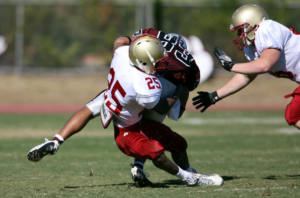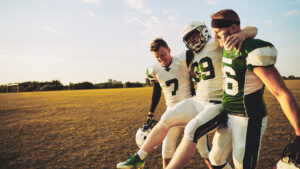It is fall time! That means football, BBQs, pumpkins, and sweater weather!
For most of the country that means sweater weather. For us Arizonans, we can throw on some jeans at night… maybe.
But, all around the country, we are ready for Football season!
I am talking about Monday Night Football leading into the Thursday Night Football special, then the Friday Night Lights, followed by the atmosphere of College Football Saturdays, just to lead up to the big Football Sundays.
The action, the big hits, the loud fans – we love it all! Like most Americans, we cannot get enough!
One of the big, often not discussed, things that happen around this time are increased injuries as well. Football is played at many different levels throughout the season. It is a very high-contact sport. Injuries in football happen.
In fact, injuries are an inevitable part of sports.
As your leading Sports Physical Therapists in the East Valley, we work to prevent and rehabilitate injuries to decrease time away from the sport.
The best rehabilitation of injuries is through prevention. And what better way to prevent injuries than by educating you on the most common injuries?
To do that, you need a basic knowledge of how we categorize injuries.
First, you must understand the difference between contact and non-contact injuries.

Contact injuries are just what you think. They occur from contact between players. These could be players of opposing teams or the same team.
An example of a contact injury is when an offensive lineman is blocking their man and the running back misses the hole the lineman created. This causes the running back to step on the back of the lineman’s ankle. Stupid running backs missing the hole….
Non-contact injuries are the opposite. They occur without having to have contact between players.
An example of a non-contact injury would be when a receiver is running a post and the quarterback leads him beautifully out in front of the defensive back. The receiver is not quite as fast as the quarterback thought though and the receiver dives with an outstretched arm to catch the ball. But, when the receiver landed, he ‘jammed’ his shoulder.
Overuse injuries are an example, a sub-classification, of a non-contact injury. It is defined as an injury caused by repetitive movement.
There are a lot of reasons for an overuse injury to occur, but to sum it up: it is from doing too much after too little or too little after too much. It often occurs when you have a significant change in your normal routine.
For example, going from your off-season of training as a quarterback and not doing any throwing. Then, getting into summer camp 7 vs 7 drills with the typical quarterback drills occurring while at practice.
One of the less talked about reasons for overuse injuries is because of early sports specialization. This means young athletes play one sport all year round.
Overuse injuries occur in our muscles, tendons, ligaments, and even nerves.
How do you prevent overuse injuries?
The best advice is adequate rest, focus on recovery strategies such as sleep, and slowly ramp up your throwing frequency/distance.
Also, participating in multiple sports to avoid overuse injuries from the specialization of sport is crucial at a young age when looking to prevent overuse injuries.
As much as you can and want to use preventative measures to try and avoid injuries, you are playing a sport. A high-contact sport at that.
Injuries are not going away anytime soon.
As we discussed in our other blog about how athletes are getting stronger and faster, more power comes with more responsibility…to take care of your health before the injury gets the best of you.
Football is the main highlight of the fall season. The big lights, cheer squads, ruthless fans, and passionate coaches are all part of what makes this season great!
Here are the most common injuries in football…
Shoulder Tendonitis
Shoulder tendonitis is a common overuse injury in football. Tendonitis is inflammation or irritation of a tendon. This is caused by a strain or injury (collisions or falling on an outstretched arm) as well as repetitive movement (ex. throwing).
It is often caused by doing too much too fast or continued repetitive movements (ex. quarterback throwing the ball). We have already discussed how a proper ramp-up period is needed to get into the throwing season. And, taking time off is important for recovery.
Throwing is a very dynamic sport. You throw with your arm, but you’re using your whole body to create power. If it is missing power from somewhere, it will find it and produce it. Just not always in the most efficient manner.
If you’re lacking mobility or strength in certain areas, it can create an unnecessary load or strain on your shoulder, leading to shoulder pain and eventually tendonitis.
You need to focus on creating and ensuring a well-balanced strength training program. It will also help decrease the risk of developing shoulder tendonitis.
Shoulder Dislocations
Shoulder dislocations are a common contact injury in football. They typically occur when being tackled. The shoulder can dislocate due to the force of the tackle or the force of hitting the ground.
Dislocations are common amongst quarterbacks because they have a high chance of having their arm outstretched when being sacked.
95% of shoulder dislocations occur anteriorly (the shoulder moves forward). The trouble with a dislocation is it’s more likely to occur after it’s happened once.
This is due to the damage to the surrounding structures as well as the laxity.
It’s like driving over a dirt road enough times that you create a path of tire tracks. You’ve now created a path for yourself. A shoulder dislocation creates a “path” for the shoulder to dislocate again.
Getting the shoulder evaluated for laxity and strength is crucial for creating a plan to decrease the risk of a dislocation occurring again.
Knee Injuries
I know knee injuries aren’t a specific diagnosis, but that is because there are so many injuries that occur at this joint in football that we had to add them in here. And, they are almost equally split between contact and non-contact injuries.
Contact injuries are typically encountered during a tackle or when getting rolled up on.
Non-contact injuries can happen at any time, but often when trying to accelerate/decelerate or change direction quickly.
In both contact and non-contact, structures such as the ACL, MCL, LCL, PCL, and meniscus can be involved.
There are many injuries that happen in the knee. The main point is to know that it is common to have contact and non-contact injuries at the knee when playing football.
The best way to reduce the risk of that sort of injury is to work with a professional to find those deficits and make them become strengths. Again, you can’t completely make the risk of injury 0%, but you can reduce it with a well-thought-out and implemented program.
If an injury in the knee does occur, it is even more vital to find a specialist who is well versed in treating this type of injury for this sport. Having even more time away from football because it was not rehabilitated efficiently is devastating for those athletes.
Ankle Sprains
Ankle sprains typically happen when changing directions or when you’re being tackled or tackling someone and your ankle rolls, twists, or moves in a different direction than intended.
It’s very difficult to walk on and it swells and bruises quickly. This can occur in low and high ankle sprains.
Most people think of rest, ice, elevation, and compression. That’s old news. What you really should do is move and use your ankle within your tolerance.
Nothing gets better by sitting back and hoping. These pro athletes are getting around-the-clock treatment to rehabilitate ankle sprains. You may not have that privilege, but that doesn’t mean you should take a passive approach when they take an active approach.
If you have an ankle sprain, it is imperative to get it assessed by a qualified professional and start the process of regaining motion, decreasing swelling, and gaining strength back right away. Especially if you are looking to get back to the field as soon as possible, at a high level.
Pulled/Strained Muscles
A pulled (strained) muscle is the result of an overstretch or tear of muscle or tendon fibers.
In football, they typically occur in the quadriceps or hamstring muscle.
They can be a result of fatigue, overuse, or not being warmed up properly. Often seen as something that is prevented before a game, which is true, but it is prevented with proper training.
The training to prevent a pulled muscle should consist of heavy strengthening to prepare the body to handle that time of strength. Training should include explosive components so that your body knows how to react to quick bursts. Your training should also include strength and explosive components when fatigued so, during your competition, your body can remember these times and properly recruit the right body parts for the job.
The sad truth is: muscle strains can become chronic if not treated properly. In regard to sports injuries, the more chronic the injury, the longer the recovery time, which means more games are missed.

Those are the 5 most common types of injuries. It includes contact and non-contact injuries, as well as shows how there can be combinations of contact and non-contact injuries. Injuries CANNOT be prevented. But, you can REDUCE THE RISK of an injury with a properly thought out and implemented training program.
But, since injuries do occur, it is even more important to find someone you trust and who is respected for their care of athletes. Nothing says wasting your time more than going to get treated by the same person who is treating 95-year-olds who are having balance difficulties and having to treat the football athlete recovering from a hamstring strain the next hour.
Find a specialist to help you stay on the field and get back on the field, performing your best.
Want to see if you qualify for our services? We offer a free Discovery Visit where you will be screened to see if you are a good fit for our services. Feel free to fill out the form and see if we may help you and your football future!




